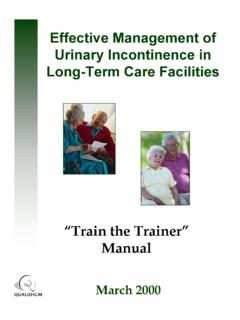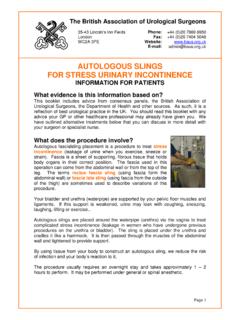Transcription of Helping you understand bladder and bowel health …
1 bladder health Helping you understand bladder and bowel health bowel health A supportive guide for carers An introduction to bladder and bowel health A healthy bladder and bowel is We have produced this booklet to inform extremely important for your overall you of common issues relating to bladder and bowel problems. There are a well being. However today, in the wide range of medicines and products United Kingdom, many people available to alleviate almost all disorders, su er from these problems. It is and the amount of advice and support is often seen as an embarrassing continually growing. subject and people su er in silence. There are a number of misconceptions and myths that are associated with these For further help and guidance problems. This guide has been produced to help answer any questions and also please use our self examination provide support for you, or someone chart on page 39.
2 Who you are caring for. Many of the problems can be managed effectively, if not cured completely. With a little help from family and friends, you will soon be able to regain your quality of life. This publication has been produced in association with: Adrian Wagg, MB, FRCP, FHEA. Professor of Healthy Ageing Divisional Director, Geriatric Medicine University of Alberta, 300 Campus Tower 8625 - 112 Street NW. Edmonton, AB T6G 1K8. 2. bladder health Contents Introduction 2. The anatomy and physiology of the bladder 4. What is a healthy bladder ? 6. How to keep your bladder healthy 6. How to find your pelvic floor muscles 7. What is an unhealthy bladder ? 8. Stress incontinence 8. Overactive bladder 9. Helping to retrain an overactive bladder 10. Underactive bladder 11. Outflow obstruction 12. Impaired functional ability 13.
3 Managing bladder problems 14. Seeking help and treatment 15. The anatomy and physiology of the bladder The urinary system This is composed of two kidneys, the The pelvic floor muscles help prevent ureters, the bladder and the urethra. leaks. They are made up of several layers Urine is made by the kidneys and of muscle which hold the bladder in place and provide support. This muscle is carried to the bladder by the two part of the anatomy of both men and ureters where it is stored until you women. go to the toilet. The female Kidneys urinary tract Ureters bladder pelvic floor muscles Urethra 4. bladder health There are 3 openings through the pelvic In males, the prostate gland surrounds floor in women and 2 in men the anus , and lies in the wall of the urethra, just the vagina and urethra in women and the below its connection with the bladder .
4 Anus and urethra in men. The muscles support these 3 openings, but if they are weakened or not in good condition they cannot support the openings effectively. The male urinary tract Kidneys Ureters bladder Prostate gland pelvic floor muscles Urethra 5. What is a healthy bladder ? The bladder has several functions : Holds up to 500mls of urine Empties at a convenient time On demand in a socially acceptable manner How to keep your bladder healthy The bladder is controlled by a complex co-ordination of nerves and muscles. Any disruption to this control mechanism may cause the bladder to leak urine. This is known as incontinence. By following this simple health planner you may be able to ease your bladder symptoms. Drink 1 1 litres of uid per day, including that in your food. Some people nd that ca einated drinks seem to make their bladder misbehave - if you notice this then try swapping to ca eine free alternatives.
5 Diet Follow a healthy diet. Overweight people have more bladder problems and maintaining a healthy weight can help solve these. health check Ask your doctor or health care provider if you are on any medication that might be making your bladder problems worse, and if this is the case, can they be changed? Exercise General tness, brisk walking etc. can help bladder problems such as having to get up frequently at night to pass urine. pelvic oor muscle strengthening shown opposite is also a good way of Helping 6. How to find your pelvic floor muscles bladder health Imagine that you are trying to stop yourself passing wind. Squeeze the muscles around the back passage. This is the back part of the pelvic floor. Now imagine that you are about to pass urine. This is the front part of the pelvic floor. Do not: squeeze your legs together; tighten your buttocks or hold your breath.
6 Exercise one pelvic Floor x 10. Tighten the pelvic Try to build up to Rest for a couple of floor as long and as a maximum of seconds and then repeat hard as you can. 10 seconds. 10 times. Exercise two x 10. Draw in the pelvic floor Repeat in short Try to do these and hold for one second succession up to exercises 6 times a before relaxing. 10 times. day for 12 weeks. 7. What is an unhealthy bladder ? There are many di erent medical terms to describe the di erent types of incontinence and it can be a di cult subject to understand . The main problems are : Stress incontinence The pelvic floor muscles provide a sling like support for the pelvic organs and they are very important in maintaining bladder control. If the muscles and ligaments become weakened stress incontinence can result. The symptoms are leakage of urine pelvic Floor when coughing, laughing, sneezing or exercising.
7 The pelvic floor muscle can weaken for Treatments many reasons. The most commonly known cause is childbirth, other causes pelvic floor exercises are the first are chronic cough, menopause, chronic treatment, they need to be constipation and obesity. performed several times a day and it can take 3 months or more before an improvement is seen. Referral is sometimes made to a specialist physiotherapist for further assessment and treatment. As a last resort, if the pelvic floor exercises do not work then there are a variety of operations which can, you should discuss this with your doctor 8. bladder health Overactive bladder 1. Someone with an overactive bladder will get a sudden urge to pass urine, and will 2. need to go to the toilet frequently. They may also have to get up more than once a night. If a toilet is not readily accessible incontinence may occur.
8 Often the cause 3. is unknown. There are many causes of these symptoms however, and your doctor will be able to advise. People with conditions of the nervous system, stroke, Parkinson's disease may have an overactive bladder . Treatments Many people with this type of bladder retraining The aim of incontinence think that reducing fluid bladder retraining is to restore intake will help relieve symptoms; this normal bladder function by teaching can in fact have the opposite effect. the bladder to hold on for longer Concentrated urine aggravates the periods. bladder and can make symptoms worse. Fluids adjusting the fluid type and Overactive diagram: intake can often relieve the 1. Normal position of bladder muscles. frequency and urgency. 2. The bladder senses that it needs to Medication As prescribed by empty, regardless of whether its full the GP, these can help relax' the and sends strong signals to your bladder enabling it to store more brain telling it to contract the urine.
9 bladder to empty. 3. Which leads to an unstoppable urge to pass water called urgency. 9. Helping to retrain an overactive bladder To help retrain the overactive bladder use a bladder and uid chart see example below . Monitor the times you pass urine and the amount of liquid you drink over a period of three days. After completing your three day chart try and delay emptying your bladder by ve minutes each time. Once you have managed this, try increasing the time of delay to ten minutes. 10. bladder health Underactive bladder 1. The underactive bladder does not produce a strong enough contraction to 2. empty and can lead to urine being left behind in the bladder . This can result in the bladder becoming 3. over stretched and enlarged. The underactive bladder can be caused by damage to the nerves that control the bladder or by obstruction to the urethra by the prostate in men.
10 The symptoms are frequency, straining to Treatments pass urine, recurrent urine infections and dribbling. Toilet techniques This may promote better bladder emptying. Underactive diagram: Intermittent catheterisation . 1. Normal position of bladder muscles. A small catheter is inserted into 2. Weak bladder muscles don't the bladder to drain the urine. This contract enough. may need to be done several times a day. 3. Which leads to a reduced flow of urine. An indwelling catheter . As a last resort this may be a preferred option. 11. Out ow obstruction This occurs when there is a blockage of the urethra making it di cult for urine to pass through. The most common cause is an enlarged prostate gland. The prostate gland is doughnut shaped and sits at the base of the bladder surrounding the urethra. The prostate gland becomes enlarged as a natural part of ageing.

